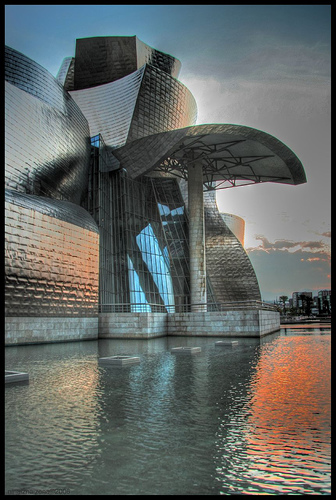October 9th, 2007 — 12:00am
JG Ballard is one of the most architecturally oriented writers I know. His writing evokes the physical and mental experiences of spaces and places deftly and vividly. No accident then that Ballard’s work is connected to psychogeography by many (an idea I’ve mentioned before as well). And so it is a pleasure to read his piece on Gehry’s Bilbao Guggenheim, The larval stage of a new kind of architecture, in Monday’s Guardian.

From the article:
More to the point, I wonder if the Bilbao Guggenheim is a work of architecture at all? Perhaps it belongs to the category of exhibition and fairground displays, of giant inflatables and bouncy castles. The Guggenheim may be the first permanent temporary structure. Its interior is a huge disappointment, and confirms the suspicion that the museum is a glorified sales aid for the Guggenheim brand. There is a giant atrium, always a sign that some corporation’s hand is sliding towards your wallet, but the galleries are conventionally proportioned, and one can’t help feeling that they are irrelevant anyway. The museum is its own work of art, and the only one really on display. One can’t imagine the Mona Lisa, the Venus de Milo or Picasso’s Guernica ever being shown here. There would be war in heaven. Apart from anything else, these works have a dimension of seriousness that the Guggenheim lacks. Koons’ Puppy, faithfully guarding the entrance to the enchanted castle, gives the game away. Architecture today is a visitor attraction, deliberately playing on our love of the brightest lights and the gaudiest neon. The Bilbao Guggenheim’s spiritual Acropolis is Las Vegas, with its infantilising pirate ships and Egyptian sphinxes. Gehry’s museum would be completely at home there, for a year at least, and then look a little dusty and jaded, soon to be torn down and replaced by another engaging marvel with which our imaginations can play.
Novelty architecture dominates throughout the world, pitched like the movies at the bored teenager inside all of us. Universities need to look like airports, with an up-and-away holiday ethos. Office buildings disguise themselves as hi-tech apartment houses, everything has the chunky look of a child’s building blocks, stirring dreams of the nursery.
But perhaps Gehry’s Guggenheim transcends all this. From the far side of the Styx I’ll look back on it with awe.
Comment » | Architecture
October 17th, 2005 — 12:00am
Art Interactive and Glowlab, a local “network of psychogeographers” is using Central Square as an exhibition and investigation space for the next nine weeks, conducting experiments with laughing bicycles, art/clothing made from trash, and other psychogeographic phenomena.
Wikipedia says, “Psychogeography is “The study of specific effects of the geographical environment, consciously organised or not, on the emotions and behaviour of individuals”, according to the article Preliminary Problems in Constructing a Situation, in Situationniste Internationale No. 1 (1958) .”
I first heard the term psychogeography while reading J.G. Ballard’s The Terminal Beach, Concrete Island, and Crash. Richard Calder is a more recent example of a writer working with these ideas. (Note to the curious: Calder’s writings include some *unusual* tastes and flavors.) Calder may have optioned one of his novels for film production. Of the members of the Situationist International mentioned by Wikipedia, I’m most familar with Guy Debord’s writings, from quite a few semina sessions on media theory, cultural theory, postmodern theory.
Regardless of psychogeography’s origins, all roads lead to the internet now: a quick Google query turns up psychogeography.org.uk, which links to an essay titled Dada Photomontage and net.art Sitemaps that compares Dadaist photomontages to the familar sitemap. The first two citations in the piece are the Yale Style Guide, and Tufte’s Visualizing Information.
The circle closes easily, since one of the link threads leads to socialfiction.org, where you find a page on [Generative] Psychogeogrpahy. Random note; socialfiction’s banner carries references to “carthographic sadism * gabber avant-gardism * experimental knowledge * DIY urbanism” – all likely cadidates for Amazon’s SIP statistically improbable phrases listings. Perhaps most intriguing is “disco socialism”. Now that might catch on in some public policy circles that could use a bit of help picking a good back beat…
A quick selection of events that looked interesting:
TUESDAY NOVEMBER 15TH, 6:30PM – 8:30PM
6:30PM – 8:30PM: N55 Artist Talk & Dinner
Hosted with the Center for Advanced Visual Studies at MIT
Danish artists’ group N55 creates mobile tools and situations for everyday living: a workplace, a modular boat, a shop, a factory, a clean air machine, a commune, and even a personal rocket. Food & Drink provided. NOTE: This event is hosted at CAVS, 265 Mass Ave, 3Fl (Bldg N-52, Rm 390), Cambridge MA.
THURSDAY OCTOBER 27TH, 6PM – 9PM
6PM – 9PM: Glowlab Party!
Hosted by the Boston Society of Architects. All young artists, designers, architects and their friends are invited to enjoy good food and cheer and become a part of a growing network of young professionals who are shaping the future of Boston. Free drinks & entertainment. RSVP to bsa@architects.org.
For those of you with fashion inclinations (spurred by watching too much InStyle?)
SATURDAY DECEMBER 10TH, 12PM – 6PM
12PM – 5PM: DIY Wearable Challenge
Make an interactive outfit from Cambridge trash and discarded electronics Led by Jonah Brucker-Cohen and Katherine Moriwaki.
Related posts:
Comment » | Architecture, Art
